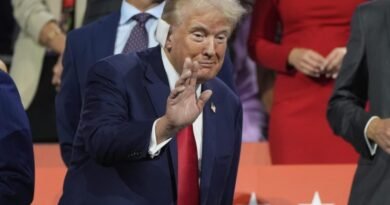Trump’s Tough Tariff Strategy Aims to Secure Improved Trade Agreements
President Trump and his team are informing key financiers that his tariff plan announced today is strategically aimed at the long term. The goal is to persuade trading partners, who have been protectionist, to lower or eliminate their barriers to U.S. exports in return for similar actions from the U.S.
Ultimately, they argue, this approach will leave everyone satisfied — including the American public, who will benefit from the eventual economic prosperity.
However, sources tell The Post that leading Wall Street executives have cautioned the White House and Trump in recent days about the challenging nature of achieving this long-term benefit.

This could lead to considerable short-term hardship, extending beyond volatile markets. It may trigger stagflation, characterized by rising prices, or inflation, and reduced growth, potentially resulting in a recession. This could represent a disruption to the economy not experienced in decades as we overhaul the global trade landscape and confront the industrialized world over tariffs.
Wall Street analysts have indicated that this poses the most significant existential threat to the Trump presidency, rendering the current DOGE controversy trivial by comparison.
Will Trump risk playing this high-stakes game? He understands that trading partners will likely retaliate; U.S. goods could become pricier abroad, leading to increased import costs. This is where stagflation becomes a concern. Those familiar with Trump suggest he is firmly committed to the tariff strategy, believing it will reinvigorate America, return jobs to the Rust Belt, and rectify the unfair trade agreements made with even our allies.
However, it is uncertain how stagnation might influence a politician, even one as resolute as Trump — a sentiment reinforced by the warning from financiers in recent discussions.
The White House was reportedly attentive during these conversations as Wall Street executives outlined the harsh realities of the anticipated short-term tariff impact: uncertainty regarding Trump’s announcements has already hampered business investment across many sectors. This hesitation is expected to escalate once the tariffs are put into effect.
U.S. automakers are preparing for price increases due to their reliance on overseas parts. Trump has announced a 25% tariff on imported vehicles.
According to Wedbush analyst Dan Ives, “The notion of a U.S. car maker sourcing all parts domestically is a fantasy… tariff policy will wreak havoc on the global auto industry and likely lead to a price hike for the average U.S. consumer by $5,000 to $10,000 right from the start.”
These tariffs will also impact farmers, who rely on grain exports, particularly to China. Our natural gas exports may suffer, resulting in a slowdown of growth on top of the spending cuts businesses have already implemented in anticipation of the tariff announcement.
On the bright side, however, there is potential for positive outcomes down the line: Trump’s deal-making abilities could transform the protectionist behaviors of our trading partners.
His aim is to bring such practices to an end, and if they comply, he has indicated he will reciprocate, restoring and possibly enhancing normal trade relations with no inherent disadvantages for U.S. exports, potentially bringing jobs back home.
His negotiations with China may serve as a model. He enjoys a good rapport with President Xi and has compelling reasons to negotiate; nonetheless, he’s imposing a 34% tariff on imports from China.
All of this is contingent on reaching an agreement.
Trump needs China to enhance their purchase of U.S. goods. Additionally, he seeks their approval for his TikTok acquisition to secure it in U.S. hands, alongside the privatization of Chinese-operated ports at the Panama Canal to an American company. Conversely, China requires access to our markets.
Combining these factors creates an environment ripe for negotiations, potentially minimizing the duration of the impending short-term pain.



